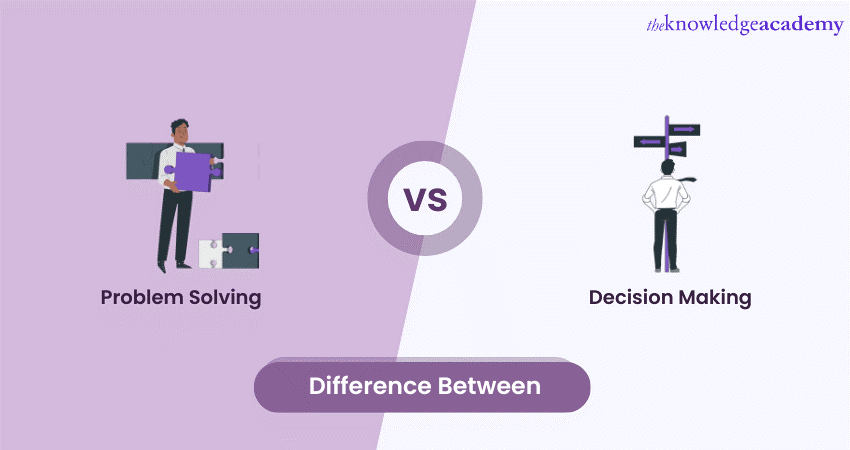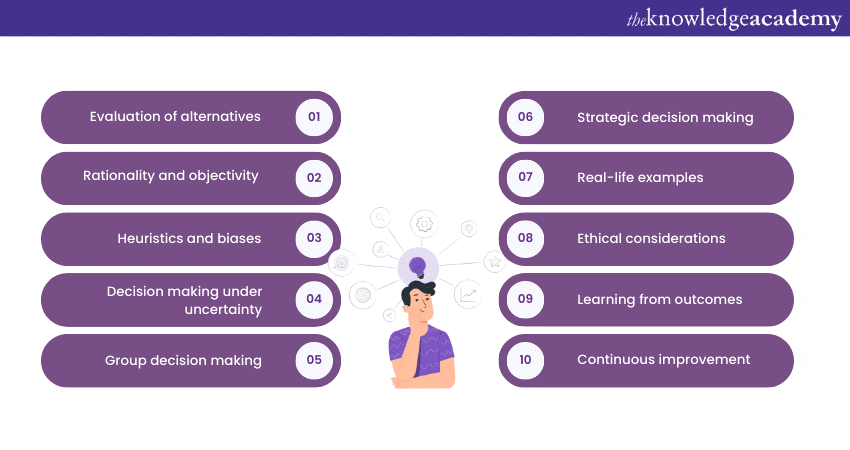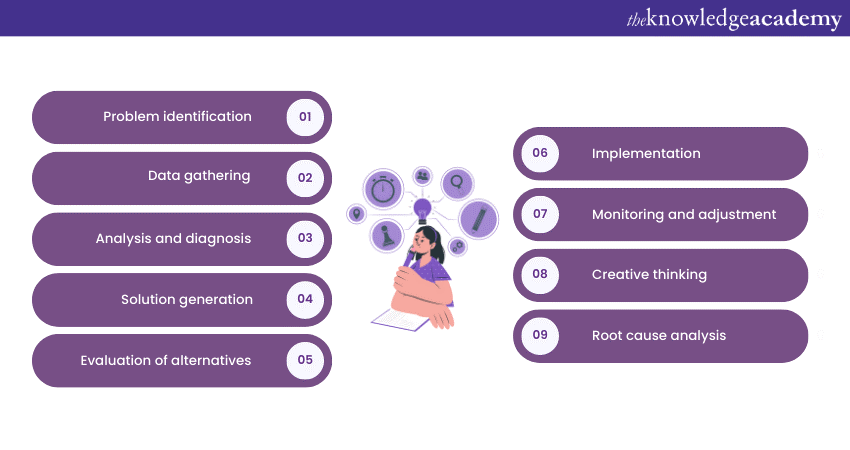We may not have the course you’re looking for. If you enquire or give us a call on 01344203999 and speak to our training experts, we may still be able to help with your training requirements.
Training Outcomes Within Your Budget!
We ensure quality, budget-alignment, and timely delivery by our expert instructors.

Have you ever faced the trouble of deciding what is right or wrong? In our daily lives, we often come across situations that require us to confront challenges and make choices. This is why two critical cognitive processes are involved in addressing these situations: Problem Solving and Decision Making. While the terms are frequently used interchangeably, they represent distinct mental activities with specific objectives. Problem Solving involves identifying and resolving issues using critical thinking and creativity. On the other hand, Decision Making entails choosing the best course of action among alternatives and considering risks and rewards. In this blog, we will Learn the differences between Problem Solving and Decision Making, how to apply these abilities at work, and some advice on how to improve them.
Table of Contents
1) What do you understand by Decision Making?
2) Understanding Problem Solving
3) What are the differences between Problem Solving and Decision Making?
4) Tips on how to improve Problem-solving and Decision-making skills
5) How can you integrate Decision Making and Problem Solving?
6) Conclusion
What do you understand by Decision Making?
It is a hard choice for all of us when we are faced with the responsibility to make important decisions, both in the workplace and personal life. However, instead of getting afraid, we can tackle these important tasks by fully understanding the implications of our decisions. Before getting to know the differences between Decision Making and Problem Solving, let us first understand about Decision Making.
It is a cognitive process that plays an essential role in our personal and professional lives. It involves evaluating different options and selecting the most appropriate course of action based on various factors and objectives.
Effective Decision Making requires a combination of critical thinking, analysis, and judgment, and it can have a significant impact on outcomes and consequences. Let's uncover the important steps to Decision -making and some real-life examples:

1) Evaluation of alternatives: As a first step, you can start Decision Making by identifying and generating possible alternatives to address a given situation or problem.
2) Rationality and objectivity: Making a correct rational decision involves a systematic analysis of available information, weighing the pros and cons of each alternative, and choosing the most logical and beneficial option.
3) Heuristics and biases: In some cases, you may have mental shortcuts to make decisions quickly. However, remember that these shortcuts can also introduce biases and lead to suboptimal choices.
4) Decision Making under uncertainty: Often, decisions must be made with incomplete or uncertain information. This requires you to make risk assessments. You also need to have the ability to adapt to changing circumstances.
5) Group Decision Making: In collaborative environments, decisions may be made collectively through group discussions, brainstorming, and consensus-building. This approach leverages diverse perspectives and expertise.
6) Strategic Decision Making: In organisations, you need to make strategic Decision Making. It involves considering long-term implications, aligning decisions with organisational goals, and anticipating potential impacts on stakeholders.
7) Ethical considerations: Ethical Decision Making involves assessing the moral implications of choices. It revolves around making decisions that align with your values and principles.
8) Learning from outcomes: To be an effective decision-maker, you need to learn from both successful and unsuccessful outcomes to improve your future Decision Making processes.
Here are some real-life examples that may require you to make some justified decisions:
a) Choosing between two job offers based on salary, benefits, and career prospects.
b) Deciding which college or university to attend, considering factors like location, courses offered, and campus culture.
c) Selecting an investment option after analysing risk, return potential, and financial goals.
d) Determining the best marketing strategy for a new product launch, considering target audience, budget, and competition.
e) Making a medical treatment choice for a patient after weighing the benefits, risks, and patient preferences.
Gain a deeper understanding of yourself to take more effective Decision Making with our Personal & Organisational Development Training .
Understanding Problem Solving
You're now aware of how you can make effective Decision Making. Let us now learn how to effectively carry out Problem Solving tasks in our daily life. Problem Solving is a critical cognitive process that allows individuals to address obstacles, overcome difficulties, and achieve desired outcomes.
It involves a systematic approach to understanding the issue, identifying possible solutions, and implementing the most effective resolution. This helps you to navigate complexities and arrive at successful conclusions. Let us now look at some tips that can help you in Problem Solving effectively:

1) Problem identification: As a first step towards Problem Solving, effectively carry out tasks. Also, recognise and define the issue or challenge that needs to be addressed.
2) Data gathering: Gathering relevant information and data related to the problem is essential for understanding its root causes and implications. This helps you become a good problem solver.
3) Analysis and diagnosis: Analyse the gathered information to identify the underlying causes of the problem. This helps you in devising targeted solutions.
4) Solution generation: Brainstorming and generating multiple potential solutions is crucial for you when you are exploring diverse approaches to resolve the problem.
5) Evaluation of alternatives: Carefully evaluate the pros and cons of each solution. This helps you in selecting the most feasible and effective one.
6) Implementation: After choosing a solution, you have to put the chosen solution into action. This requires planning, coordination, and effective execution.
7) Creative thinking: Employing creative thinking approaches can lead you to have innovative solutions to complex problems.
8) Root cause analysis: Identifying and addressing the root cause of a problem ensures that you have a more sustainable and lasting solution.
Let us now see some real-life examples where you need to apply your Problem Solving skills:
a) Resolving a technical issue with a computer by identifying and troubleshooting the actual cause of the problem.
b) Finding an alternative transportation route when faced with unexpected road closures.
c) Addressing a communication breakdown within a team by facilitating open discussions and conflict resolution.
d) Solving a math problem by applying various Problem Solving Techniques and mathematical principles.
e) Fixing a malfunctioning appliance by diagnosing the issue and performing necessary repairs.
Learn to be more Mindful when you are applying your Problem Solving skills with our Conflict Management Training .
What are the differences between Problem Solving and Decision Making?
Let us now have a look how Problem Solving and Decision Making skills are different from each other:
|
Aspect |
Decision Making |
Problem Solving |
|
Definition |
Selecting from available alternatives to achieve a specific goal or outcome. |
Identifying and resolving an issue or challenge to reach a desired state. |
|
Objective |
Making a choice among options. |
Finding a solution to a problem |
|
Focus |
Choosing the best course of action. |
Understanding the problem and generating potential solutions |
|
Process |
Evaluating alternatives, considering risks and rewards. |
Identifying the problem, gathering data, analysing, and implementing solutions. |
|
Rationality |
Often involves a logical and systematic approach. |
Requires critical thinking and creativity. |
|
Input |
It involves available information and past experiences. |
Data and insights related to the problem at hand. |
|
Outcome |
Leads to a final decision. |
Results in a resolved problem or improved situation. |
|
Examples |
Often applied to challenges or obstacles in various domains. |
Troubleshooting technical issues and finding solutions to production problems. |
| Interrelation | Decision-making may follow effective Problem-Solving. | Effective Problem-solving often leads to better Decision-making. |
| Context | Applicable to a wide range of situations. | Often applied to challenges or obstacles in various domains. |
1) Definition
Problem Solving is a systematic process to identify, analyse, and resolve issues or challenges. It involves understanding the root cause of a problem, generating possible solutions, and selecting the best course of action. This approach aims to eliminate or reduce the negative impact of the issue.
On the other hand, Decision Making is the process of choosing among various alternatives. Every Decision Making process yields a choice that can be an action, a strategy, or a resolution. It doesn’t necessarily need a problem; it can be any situation requiring a choice.
2) Objective
The main objective of Problem Solving is to overcome an obstacle or challenge. It aims to transform the current undesirable situation into a desired state. On the contrary, the primary goal of Decision Making is to select the best possible choice out of multiple alternatives. It could be proactive, like deciding on a strategy for market expansion, or reactive, like choosing a course of action in response to a competitor's move.
3) Nature
The process of Problem Solving is often reactive. It arises when a discrepancy occurs between the expected outcome and the actual outcome, necessitating a solution. However, in Decision Making it can be both proactive and reactive. Proactive Decision Making involves making choices in anticipation of future events, while reactive Decision Making responds to an immediate situation or problem.
4) Process
The process of Problem Solving often begins with understanding and diagnosing the problem. It is then followed by brainstorming potential solutions, analysing the feasibility of each solution, and finally, implementing the most suitable one.
Whereas, in Decision Making, the process typically starts by identifying a need, gathering information, identifying alternatives, weighing them based on criteria like risks, benefits, and implications, and then selecting the best option.
5) Tools and techniques
In Problem Solving, the common tools include Root Cause Analysis, Brainstorming, SWOT Analysis, and fishbone diagrams (Ishikawa). These tools help identify the origin of a problem and explore possible solutions.
On the other hand, Decision Making involves techniques that are often used such as decision trees, cost-benefit analysis, pros and cons lists, and grid analysis. These help in evaluating the implications of each available choice.
6) Skills required
In Problem Solving, the major skills required are critical thinking, analytical skills, creativity, and resilience. The ability to persevere and not get overwhelmed when faced with challenges is vital.
However, Decision Making requires analytical skills, risk assessment, intuition, and foresight. The ability to predict the outcomes of each choice and be accountable for decisions is essential.
7) Duration and finality
Problem Solving is time-consuming. It requires a deep dive into understanding the problem before moving on to solutions. The process concludes once a solution is implemented, and the problem is resolved.
On the other hand, Decision Making can be swift (like everyday decisions) or prolonged (strategic decisions) depending on the complexity of the problems. Once a decision is made, the next step is to implement it, but decisions can sometimes be revisited based on outcomes or changing scenarios.

Tips on how to improve Problem-solving and Decision-making skills
Decision-making and Problem-solving are two most important skills that every individual must possess to excel in their career and in their personal life. There are multiple ways which can be used to improve these skills. Let’s have a look at some of these tips to improve these skills:
Developing skills related to Decision-making and Problem-solving
You can improve your Decision-making and Problem-solving skills by developing other skills such as analytical thinking, creativity and critical thinking. These allied skills will help you boost your analytical thinking skills, will help you think creatively and outside the box. Moreover, honing these skills will help you understand the problems deeply and analyse them without getting partial with your decisions.
Effective communication
Communication is the one of the major keys to success. Effective communication helps in solving problems, miscommunications and helps you understand different perspectives to the same problem. By practicing effective communication, you can convey an information or tasks seamlessly to you team members or colleagues. It helps you understand the root cause of any problem and helps you take an informed decision.
Think about past decisions
It may seem unrelated to you in this context, however, thinking back on your decisions that you made previously can help you not repeat the mistakes, or save you the time that you previously took to make a small decision. Reflecting on past decisions helpin analysing the current problems impartially and help you learn more about your own methods to decide or solve a problem.
Research your industry
Before you make any important decision, or solve out a problem, you need to know about your industry in detail. Since not all situations are same, neither are the industries. Every industry, company or business have their own set of goals, requirements, ideologies, and policies. Whenever you are a part of that specific industry, you should keep in mind, their framework. If you are going beyond their framework or their principles, while solving a problem, there may not be any significant impact taken by your decisions.
Keep yourself updated
It is necessary that you keep yourself updated. As you know that our world is going through many technological advancements. Hence you need to know and update yourself so that you can incorporate all these inventions and discoveries in your industry.
Crack Your Interview with Management Interview Questions and Answers
How can you integrate Decision Making and Problem Solving?
Even though Decision-making and Problem-solving have their differences, there are still instances where you need to integrate these two special skills so that you can carry out any challenging tasks or situations, whether it be in the workplace or in your personal life. The following tips will help you show how you can take effective decisions and simultaneously solve problems:
1) Foster a systematic approach: You can start by adopting a systematic approach to Problem-solving. It involves defining the issue, gathering relevant information, analysing data, generating potential solutions, and evaluating alternatives. Then, you can implement your structured Problem-solving process, which provides a solid foundation for your informed Decision Making.
2) Identify decision points: You can recognise the key decision points within the Problem-solving process. Then you have to determine which factors require choices and weigh the consequences of each decision on the overall Problem-solving outcome.
3) Incorporate critical thinking: You can emphasise your critical thinking throughout both Problem-solving and Decision-making. Engage in objective analysis so that you can consider multiple perspectives and challenge assumptions to arrive at well-rounded solutions and decisions.
4) Utilise data-driven decisions: Ensure that the decisions made during the Problem-solving process are backed by relevant data and evidence. Your data-driven Decision-making minimises biases and increases the chances of arriving at the most suitable solutions.
Gain a deeper understanding of yourself to take more effective Decision-mking with our Personal & Organisational Development Training.
Conclusion
If you integrate both Problem Solving and Decision Making, you can have a more potent approach toward various challenges or tasks. This will help you in making well-informed choices in those circumstances. Moreover, this synergy will empower you to have a Problem -solving mindset to navigate complexities with clarity and achieve effective outcomes.
Enhance your remote leadership skills with our Managing Remote Teams Course.
Frequently Asked Questions

Problem-solving can be defined as the act of defining a problem, determine the cause of the problem, identify and prioritise solution according to the problem. Decision-making can be defined as the process of making choices by identifying a decision, gather information, and assess alternative solutions.

There are some common barriers to effective Decision-making. These are as follows:
a) Lack of knowledge about bias and decision-making in organisations
b) Poor culture of making proper decisions
c) Diversity in thought
d) Loss aversion bias

There are mainly five steps which are involved in Problem-solving and Decision-making:
Step 1: Identifying goals
Step 2: Gathering information for weighing options
Step 3: Considering consequences
Step 4: Making your decision
Step 5: Evaluating your decision made

There are seven steps involved in the Decision-making process. These steps are as follows:
Step 1: Identify the decision
Step 2: Gather relevant information
Step 3: Identifying the alternatives
Step 4: Weighing the evidence
Step 5: Choosing among alternatives
Step 6: Taking action
Step 7: Reviewing your decision and its consequences

The Knowledge Academy takes global learning to new heights, offering over 30,000 online courses across 490+ locations in 220 countries. This expansive reach ensures accessibility and convenience for learners worldwide.
Alongside our diverse Online Course Catalogue, encompassing 17 major categories, we go the extra mile by providing a plethora of free educational Online Resources like News updates, blogs, videos, webinars, and interview questions. Tailoring learning experiences further, professionals can maximise value with customisable Course Bundles of TKA.
The Knowledge Academy’s Knowledge Pass, a prepaid voucher, adds another layer of flexibility, allowing course bookings over a 12-month period. Join us on a journey where education knows no bounds.
Upcoming Business Skills Resources Batches & Dates
Date
 Management Training for New Managers
Management Training for New Managers
Fri 31st May 2024
Fri 26th Jul 2024
Fri 27th Sep 2024
Fri 29th Nov 2024







 Top Rated Course
Top Rated Course


 If you wish to make any changes to your course, please
If you wish to make any changes to your course, please


